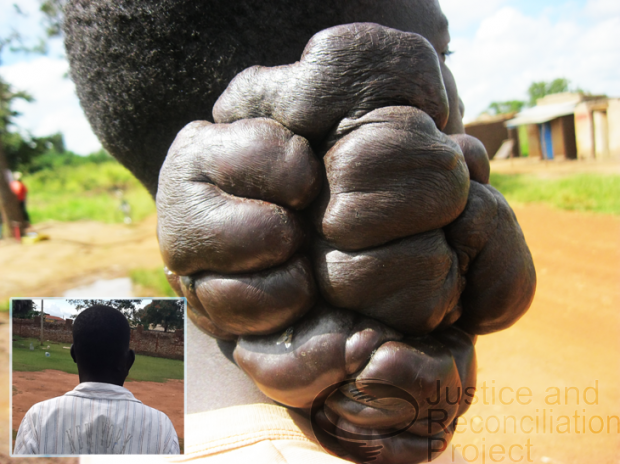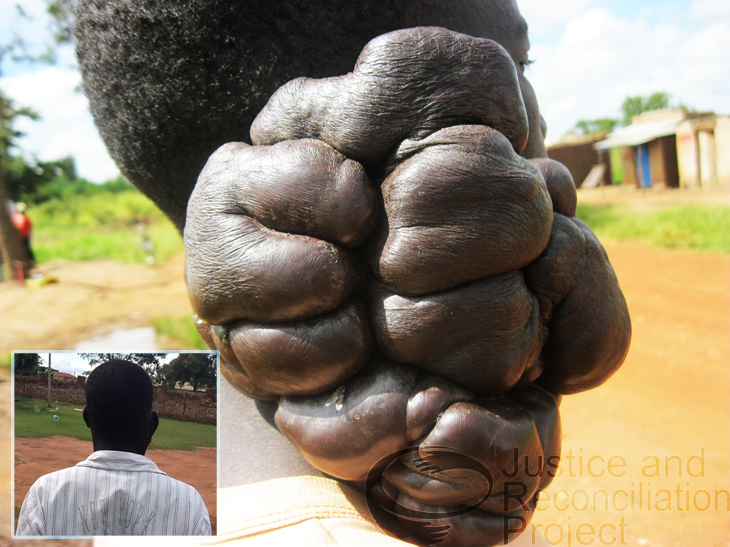
On 3 October 2012, JRP’s documentation department made one of its many field visits to Burcoro village, one of the many villages in Acholi sub-region that was affected by the conflict. Our aim was to start a documentation process with the people of Burcoro about their conflict experiences during the civil war that ravaged northern Uganda for over two decades.
JRP’s documentation chronicles the conflict-related experiences and memories of individuals, communities and victims’ groups to preserve memory, acknowledge loss and promote healing and reconciliation. We also support community-led documentation efforts. Through community and interest group documentation we build on work done over the past years in Atiak, Barlonyo, Mucwini, Omot, Palabek, Lukodi, and Mukura introducing new documentation methods to allow for broader participation.
Field visits for data collection are both interesting and unpredictable. This is because every village in northern Uganda has a unique story. In a similar light, most of the survivors living in those villages have a unique story about their survival experiences. Field visits are also unpredictable for you can neither know beforehand what exactly you will come across on each trip, nor the people you will meet.
Burcoro
We were visiting Burcoro for the first time. We had information that Burcoro village had been severely affected in 1991 by an operation conducted by soldiers of the National Resistance Army LRA (NRA) as a result of atrocities committed by these soldiers against civilians ranging from beatings, torture, illegal detentions, mass rape of women, sodomy against men, and execution of some civilians. While we knew we would come across victims, we did not know what to expect from them,
On this occasion we came across a survivor with a medical condition we had never seen before. His condition was both scaring and heartbreaking. Standing right before us and gazing vaguely as though there was no hope for tomorrow was a young boy suffering from a condition called keloids. His name was Ochen. The keloids, that was growing in his ear weighed close to 1.5 kilograms. It was delicately perched on his left ear and covered the most part of his neck. His neck appeared to be giving way to the keloids and as a result his head was tilted to the right. To show that the keloids was far from giving up in its unimaginable growth, there were still fresh wounds forming within the keloids. This emitted out pungent smell and attracted flies that constantly swarmed around him.
For a moment we were left speechless, each and every one of us looked at the other in silence as we searched for answers within us. Many thoughts came to our minds as we tried to figure out what had happened to him: Was it an incurable cancer? Was this a birth abnormality? Did he suffer gunshots? How did he manage to sleep in the night? What attention did he attract within and out of this community? Has any medical attention ever come his way? What could we do about it? It is very amazing how the human brain quickly searches for answers when it is confronted with a complex situation.
Meeting Ochen
As though he had read our minds, Ochen drew closer to us. I inquired of him how he was doing and if he was one of the respondents we were scheduled to meet that day. He never said a word but muttered something to himself. This made us even more determined to learn his story.
Ochen is 16 years old and has lived with this condition since the age of three. He told us that one day as he was running around the village, he was accidentally pierced by a tree branch and severely wounded. He was treated but after the wound healed, it left him a small lump (keloid) which began to gradually grow bigger and heavier. The growth paused slightly when Ochen was nine years old, but by then it weighed one kilogram. From then on the keloid did not show any sign of reducing in size but maintained a steady growth. Ochen experienced headache, pain on the ear and neck. He could not freely turn his head without turning the whole body. We also got to know from him that due to the growth, stigma from the community was directed at him, and Ochen dropped out of school.
We asked if he had sought any medical attention in the past. Ochen told us he had been twice operated in Lacor Hospital but the keloids kept coming back for reasons he could not explain.
While we were relieved that at least Ochen had not attained this condition as a result of the conflict that had affected his village, we were at a dilemma about how to help him. The documentation department’s mandate was not only limited to research and documentation, JRP as an organization did not offer medical rehabilitation. This is a dilemma that researchers are often confronted with when they come across people who need immediate assistance. In Ochen’s case, his condition had not even been caused as a result of a conflict experience The only option we were left with was to make a referral.
The Referral
With this in mind, we left Burcoro after having talked to many survivors and victims. We were not sure how we would get help for Ochen. But Somehow, things worked out faster than we had imagined. A few days after the encounter with this boy, I came into contact with the founder and director of a charity organization called Empowerment for Disadvantaged Youth and Children (EDYAC) and shared with him the plight of Ochen. He is a medical Doctor, and his organization works to see that youth and children with disabilities realize their full potential. After listening to Ochen story, he asked a few questions and concluded that Ochen had “to be helped as soon as now”. Within a short time he had got in contact with other medical experts and they agreed examine Ochen. Their examination revealed that Ochen needed urgent medical attention. On the 23 October 2012, Ochen together with the team from EDYAC travelled down to Kampala and he was admitted at CORSU Rehabilitation Hospital for his surgery which lasted close to eleven hours
Success
In his own words, “I entered the theatre at 7:00 am and got out of there at 6pm.” For eleven hours Ochen’s life underwent the transformation that he very much needed. And when he finally gained his consciousness at 7:00 pm, he was never the same again. His head had become much lighter, and his self esteem immediately begun returning.
On the 29 October 2012, Ochen was finally discharged from the hospital and returned to his community. He says, “When I got to Burcoro, I was a hero. All the people who used to dread my presence were the ones who struggled to come close to me. I got smiles instead of the strange stares that I would attract every time I stepped out of home.” Ochen is thankful to JRP for this referral and very humbled by the work of EDYAC.
As a researcher, the success story of Ochen lifts my spirit high. Sometimes as an individual or institution you may not have the ability or mandate to physically assist but there is always the option of referrals.
